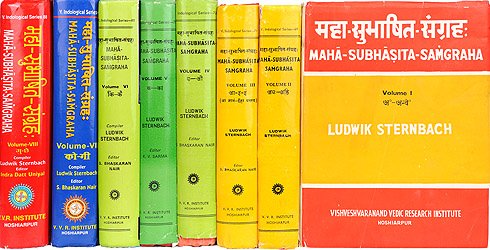Sanskrit quote nr. 6263 (Maha-subhashita-samgraha)
Sanskrit text:
ईश्वराः पिशुनाञ् शश्वद् बिभ्रतीति किमद्भुतम् ।
प्रायो निधय एवाहीन् द्विजिह्वान् दधतेतराम् ॥īśvarāḥ piśunāñ śaśvad bibhratīti kimadbhutam |
prāyo nidhaya evāhīn dvijihvān dadhatetarām ||
Index
Presented above is a Sanskrit aphorism, also known as a subhāṣita, which is at the very least, a literary piece of art. This page provides critical research material such as an anlaysis on the poetic meter used, an English translation, a glossary explaining technical terms, and a list of resources including print editions and digital links.
Glossary of Sanskrit terms
Note: Consider this as an approximate extraction of glossary words based on an experimental segmentation of the Sanskrit verse. Some could be superfluous while some might not be mentioned.
Ishvara (isvara, īśvara, ईश्वर, īśvarā, ईश्वरा): defined in 22 categories.
Shashvat (sasvat, śaśvat, शश्वत्): defined in 3 categories.
Bibhrat (बिभ्रत्): defined in 2 categories.
Iti (इति): defined in 6 categories.
Kim (किम्): defined in 4 categories.
Adbhuta (अद्भुत): defined in 16 categories.
Praya (prāya, प्राय): defined in 8 categories.
Prayas (prāyas, प्रायस्): defined in 4 categories.
Nidhi (निधि): defined in 9 categories.
Eva (एव, evā, एवा): defined in 6 categories.
Ahi (अहि): defined in 16 categories.
Dvijihva (द्विजिह्व): defined in 3 categories.
Itara (itarā, इतरा): defined in 9 categories.
Defined according to the following glossaries/dictionaries: Hinduism, Jainism, Sanskrit, Tibetan Buddhism (Vajrayana or tantric Buddhism), Shilpashastra (iconography), Vaishnavism (Vaishava dharma), Purana (epic history), Jyotisha (astronomy and astrology), Vedanta (school of philosophy), Shaktism (Shakta philosophy), Shaivism (Shaiva philosophy), Pancaratra (worship of Nārāyaṇa), Vaisheshika (school of philosophy), Mahayana (major branch of Buddhism), India history, Marathi, Hindi, Jain philosophy, Kannada, Ganitashastra (Mathematics and Algebra), Biology (plants and animals), Nepali, Pali, Prakrit, Vastushastra (architecture), Natyashastra (theatrics and dramaturgy), Yoga (school of philosophy), Arts (wordly enjoyments), Vyakarana (Sanskrit grammar), Ayurveda (science of life), Theravada (major branch of Buddhism), Dharmashastra (religious law), Kavya (poetry)
Analysis of Sanskrit grammar
Note: this is an experimental feature and only shows the first possible analysis of the Sanskrit verse. If the system was successful in segmenting the sentence, you will see of which words it is made up of, generally consisting of Nouns, Pronouns, Verbs, Participles and Indeclinables. Click on the link to show all possible derivations of the word.
- Line 1: “īśvarāḥ piśunāñ śaśvad bibhratīti kimadbhutam”
- īśvarāḥ -
-
īśvara (noun, masculine)[nominative plural], [vocative plural]īśvarā (noun, feminine)[nominative plural], [vocative plural], [accusative plural]
- piśunāñ -
-
- śaśvad -
-
śaśvat (indeclinable)[indeclinable]śaśvat (noun, masculine)[compound]śaśvat (noun, neuter)[nominative single], [vocative single], [accusative single]
- bibhratī -
-
bibhrat (noun, masculine)[locative single]bibhrat (noun, neuter)[nominative dual], [nominative plural], [vocative dual], [vocative plural], [accusative dual], [accusative plural], [locative single]√bhṛ (verb class 3)[present active third plural]
- iti -
-
iti (indeclinable particle)[indeclinable particle]iti (noun, feminine)[compound], [adverb]
- kim -
-
kim (indeclinable interrogative)[indeclinable interrogative]kim (indeclinable)[indeclinable]kim (pronoun, neuter)[nominative single], [accusative single]
- adbhutam -
-
adbhuta (noun, masculine)[adverb], [accusative single]adbhuta (noun, neuter)[adverb], [nominative single], [accusative single]adbhutā (noun, feminine)[adverb]
- Line 2: “prāyo nidhaya evāhīn dvijihvān dadhatetarām”
- prāyo* -
-
prāyas (noun, neuter)[compound], [adverb], [nominative single], [vocative single], [accusative single]prāya (noun, masculine)[nominative single]
- nidhaya* -
-
nidhi (noun, masculine)[nominative plural], [vocative plural]
- evā -
-
eva (indeclinable particle)[indeclinable particle]eva (noun, masculine)[compound], [vocative single]eva (noun, neuter)[compound], [vocative single]evā (noun, feminine)[nominative single]
- ahīn -
-
ahi (noun, masculine)[accusative plural]
- dvijihvān -
-
dvijihva (noun, masculine)[accusative plural]
- dadhate -
-
√dadh (verb class 1)[present middle third single], [imperative active second plural]√dhā (verb class 1)[present middle third single], [imperative active second plural]√dhā (verb class 3)[present middle third plural]
- itarām -
-
itarā (noun, feminine)[accusative single]
About the Mahāsubhāṣitasaṃgraha
This quote is included within the Mahāsubhāṣitasaṃgraha (महासुभाषितसंग्रह, maha-subhashita-samgraha / subhasita-sangraha), which is a compendium of Sanskrit aphorisms (subhāṣita), collected from various sources. Subhāṣita is a genre of Sanskrit literature, exposing the vast and rich cultural heritage of ancient India.
It has serial number 6263 and can be found on page . (read on archive.org)
Sanskrit is the oldest living language and bears testimony to the intellectual past of ancient India. Three major religions (Hinduism, Buddhism, Jainism) share this language, which is used for many of their holy books. Besides religious manuscripts, much of India’s ancient culture has been preserved in Sanskrit, covering topics such as Architecture, Music, Botany, Surgery, Ethics, Philosophy, Dance and much more.
 buy this book
buy this book